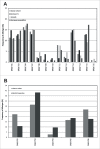A comparison of the ability of the human IgG1 allotypes G1m3 and G1m1,17 to stimulate T-cell responses from allotype matched and mismatched donors
- PMID: 26821574
- PMCID: PMC4966604
- DOI: 10.1080/19420862.2015.1128605
A comparison of the ability of the human IgG1 allotypes G1m3 and G1m1,17 to stimulate T-cell responses from allotype matched and mismatched donors
Abstract
The immunogenicity of clinically administered antibodies has clinical implications for the patients receiving them, ranging from mild consequences, such as increased clearance of the drug from the circulation, to life-threatening effects. The emergence of methods to engineer variable regions resulting in the generation of humanised and fully human antibodies as therapeutics has reduced the potential for adverse immunogenicity. However, due to differences in sequence referred to as allotypic variation, antibody constant regions are not homogeneous within the human population, even within sub-classes of the same immunoglobulin isotype. For therapeutically administered antibodies, the potential exists for an immune response from the patient to the antibody if the allotype of patient and antibody do not match. Allotypic distribution in the human population varies within and across ethnic groups making the choice of allotype for a therapeutic antibody difficult. This study investigated the potential of human IgG1 allotypes to stimulate responses in human CD4(+) T cells from donors matched for homologous and heterologous IgG1 allotypes. Allotypic variants of the therapeutic monoclonal antibody trastuzumab were administered to genetically defined allotypic matched and mismatched donor T cells. No significant responses were observed in the mismatched T cells. To investigate the lack of T-cell responses in relation to mismatched allotypes, HLA-DR agretopes were identified via MHC associated peptide proteomics (MAPPs). As expected, many HLA-DR restricted peptides were presented. However, there were no peptides presented from the sequence regions containing the allotypic variations. Taken together, the results from the T-cell assay and MAPPs assay indicate that the allotypic differences in human IgG1 do not represent a significant risk for induction of immunogenicity.
Keywords: Allotype; Epitope; HLA; IgG; Immunogenicity; MAPPs; MHC; T-cell.
Figures





Similar articles
-
Immunoglobulin G1 Allotype Influences Antibody Subclass Distribution in Response to HIV gp140 Vaccination.Front Immunol. 2017 Dec 20;8:1883. doi: 10.3389/fimmu.2017.01883. eCollection 2017. Front Immunol. 2017. PMID: 29326728 Free PMC article.
-
The human G1m1 allotype associates with CD4+ T-cell responsiveness to a highly conserved IgG1 constant region peptide and confers an asparaginyl endopeptidase cleavage site.Genes Immun. 2011 Apr;12(3):213-21. doi: 10.1038/gene.2010.68. Epub 2011 Feb 17. Genes Immun. 2011. PMID: 21326320 Free PMC article.
-
Surprising negative association between IgG1 allotype disparity and anti-adalimumab formation: a cohort study.Arthritis Res Ther. 2010;12(6):R221. doi: 10.1186/ar3208. Epub 2010 Dec 27. Arthritis Res Ther. 2010. PMID: 21187010 Free PMC article.
-
Mechanisms of mouse T lymphocyte-induced suppression of the IgG2ab allotype and T lymphocyte tolerance to IgG2ab.Arch Immunol Ther Exp (Warsz). 2001;49(6):407-15. Arch Immunol Ther Exp (Warsz). 2001. PMID: 11814234 Review.
-
Gm and Km allotypes, immune response and disease susceptibility.Monogr Allergy. 1986;19:52-70. Monogr Allergy. 1986. PMID: 3093851 Review. No abstract available.
Cited by
-
Immunoglobulin G1 Allotype Influences Antibody Subclass Distribution in Response to HIV gp140 Vaccination.Front Immunol. 2017 Dec 20;8:1883. doi: 10.3389/fimmu.2017.01883. eCollection 2017. Front Immunol. 2017. PMID: 29326728 Free PMC article.
-
Immunogenicity of biologic agents in rheumatology.Nat Rev Rheumatol. 2021 Feb;17(2):81-97. doi: 10.1038/s41584-020-00540-8. Epub 2020 Dec 14. Nat Rev Rheumatol. 2021. PMID: 33318665 Review.
-
A Quantitative Approach to Unravel the Role of Host Genetics in IgG-FcγR Complex Formation After Vaccination.Front Immunol. 2022 Feb 22;13:820148. doi: 10.3389/fimmu.2022.820148. eCollection 2022. Front Immunol. 2022. PMID: 35273603 Free PMC article.
-
Living in LALA land? Forty years of attenuating Fc effector functions.Immunol Rev. 2024 Nov;328(1):422-437. doi: 10.1111/imr.13379. Epub 2024 Aug 19. Immunol Rev. 2024. PMID: 39158044 Free PMC article. Review.
-
Beyond Allotypes: The Influence of Allelic Diversity in Antibody Constant Domains.Front Immunol. 2020 Aug 18;11:2016. doi: 10.3389/fimmu.2020.02016. eCollection 2020. Front Immunol. 2020. PMID: 32973808 Free PMC article. Review.
References
-
- Kohler G, Milstein C. Continuous cultures of fused cells secreting antibody of predefined specificity. Nature 1975; 256:495-7; PMID:1172191; http://dx.doi.org/10.1038/256495a0 - DOI - PubMed
-
- Riechmann L, Clark M, Waldmann H, Winter G. Reshaping human antibodies for therapy. Nature 1988; 332:323-7; PMID:3127726; http://dx.doi.org/10.1038/332323a0 - DOI - PubMed
-
- Jones PT, Dear PH, Foote J, Neuberger MS, Winter G. Replacing the complementarity-determining regions in a human antibody with those from a mouse. Nature 1986; 321:522-5; PMID:3713831; http://dx.doi.org/10.1038/321522a0 - DOI - PubMed
-
- McCafferty J, Griffiths AD, Winter G, Chiswell DJ. Phage antibodies: Filamentous phage displaying antibody variable domains. Nature 1990; 348:552-4; PMID:2247164; http://dx.doi.org/10.1038/348552a0 - DOI - PubMed
-
- Lonberg N. Human antibodies from transgenic animals. Nat Biotechnol 2005; 23:1117-25; PMID:16151405; http://dx.doi.org/10.1038/nbt1135 - DOI - PubMed
Publication types
MeSH terms
Substances
LinkOut - more resources
Full Text Sources
Other Literature Sources
Medical
Research Materials
